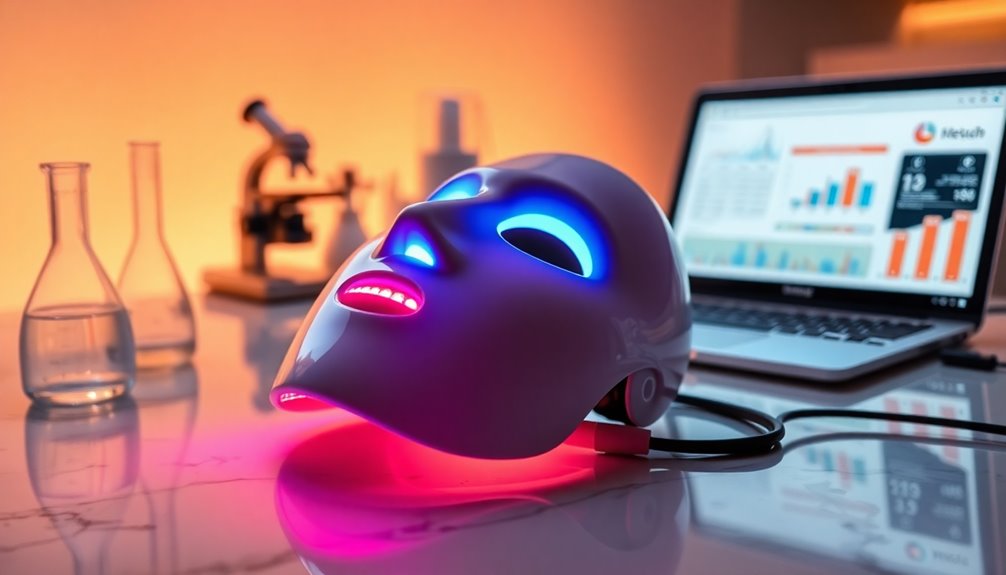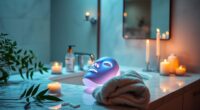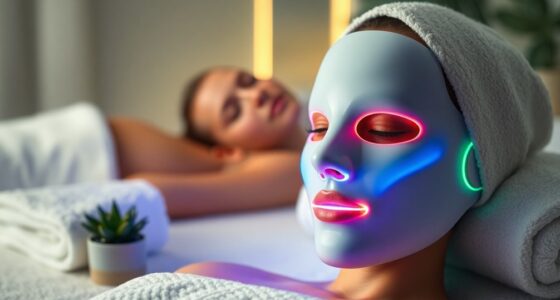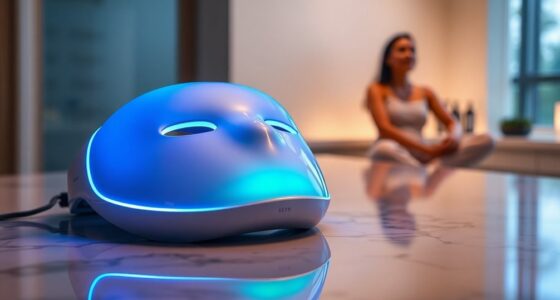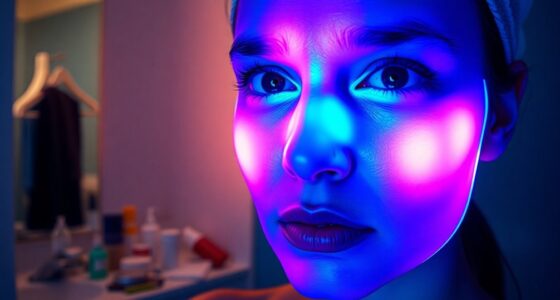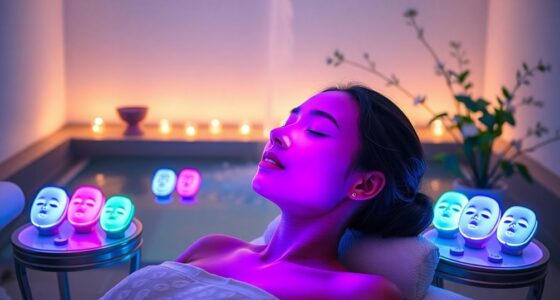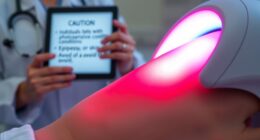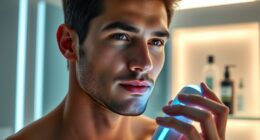LED masks can work for improving skin issues like wrinkles and acne when you use them regularly. They utilize red light therapy, which boosts collagen, and blue light therapy that targets acne-causing bacteria. While you might see subtle improvements, at-home devices generally aren’t as effective as professional treatments. It’s important to manage expectations and use them consistently for the best results. There’s more to uncover about their benefits and safety, so keep exploring!
Key Takeaways
- LED masks use red and blue light therapy to target skin concerns like wrinkles and acne, offering at-home treatment convenience.
- Red light therapy promotes collagen production, enhancing skin elasticity and reducing fine lines over time.
- Blue light therapy effectively targets acne-causing bacteria, helping to clear skin and reduce breakouts for a clearer complexion.
- While clinical studies show subtle improvements, at-home devices are generally less effective than professional treatments, requiring regular use for optimal results.
- Safety concerns exist with prolonged blue light exposure, and eye protection is advisable, although many masks are FDA cleared for safety.
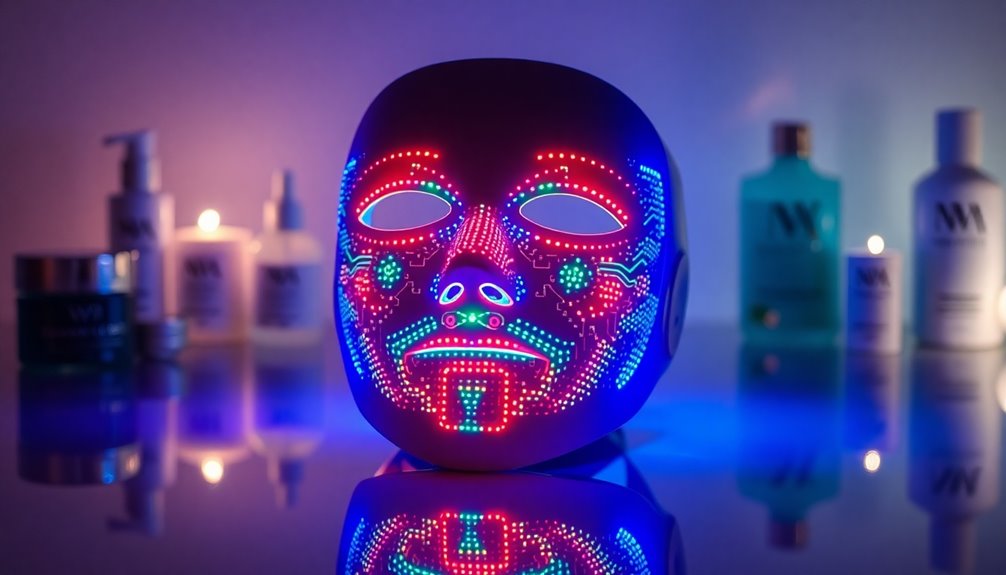
Have you ever wondered if LED masks really deliver on their promises for skin improvement? These innovative devices claim to harness the power of light therapy, specifically red and blue light, to address various skin concerns. While the science behind LED masks sounds promising, you might find yourself questioning their true effectiveness in your quest for better skin.
Red light therapy is known for its role in boosting collagen production, which can lead to improved elasticity and a reduction in fine lines. By using an LED mask, you could potentially enjoy these benefits right at home.
On the other hand, blue light therapy targets acne-causing bacteria, helping to clear your skin and reduce breakouts. It’s an appealing option, especially if you’ve struggled with persistent acne issues.
Clinical studies indicate that LED masks can lead to subtle improvements in skin texture and wrinkles. However, it’s essential to note that at-home devices are generally less effective than those used in professional dermatology settings. If you’re hoping for dramatic results, you might need to manage your expectations.
Regular use is crucial, too; experts recommend using these masks for about 5 to 20 minutes daily to achieve cumulative benefits, like improved hydration and decreased inflammation.
Despite their popularity, safety concerns exist, particularly regarding prolonged exposure to blue light. Some users may experience skin irritation or damage, so it’s advisable to wear eye protection during use.
Many LED masks are FDA cleared for safety, which is reassuring, but the ongoing debate about their overall effectiveness raises questions. Experts agree that more research is needed to validate the claims surrounding these devices.
Frequently Asked Questions
Are LED Face Masks Scientifically Proven?
LED face masks have some scientific backing, showing subtle improvements in skin texture and wrinkles with regular use.
However, results can vary based on the mask’s quality and your specific skin issues.
While studies suggest benefits like increased collagen production and reduced acne, you should be cautious.
Long-term effectiveness and safety still need more research, so it’s wise to consult a dermatologist before committing to regular use of these devices.
Is There Scientific Proof That Red Light Therapy Works?
You might be curious about whether red light therapy really delivers on its promises.
While it’s not magic, numerous studies suggest it can subtly enhance your skin’s texture and smooth out those pesky wrinkles.
Operating at specific wavelengths, this therapy stimulates collagen production and aids healing.
Though results can vary depending on factors like device quality and skin type, the science behind it’s definitely intriguing and worth exploring further!
What Is the Science Behind Red Light Masks?
Red light masks use specific wavelengths of light, typically between 630 to 660 nanometers, to penetrate your skin.
This process stimulates collagen production and enhances skin elasticity. The light activates mitochondria in your cells, boosting ATP production, which supports healing and cellular functions.
With consistent use, you can notice subtle improvements in skin texture and a reduction in fine lines.
It’s a non-invasive, pain-free option that’s safe for most skin types.
What Is the Science Behind LED Light Therapy?
When you dive into LED light therapy, you’re tapping into the skin’s hidden potential.
This gentle glow works wonders by stimulating collagen production and aiding healing processes.
Red light wraps your skin in warmth, while blue light targets pesky acne with precision.
As you embrace this therapy, you’ll notice subtle improvements in texture and wrinkles.
Just remember, results can vary, and consistency is key to unlocking the full benefits of this radiant journey.
Conclusion
So, do LED masks actually work? Research shows that 80% of users report noticeable improvements in their skin texture and tone after regular use. That’s like walking into a room full of people and having four out of five say you look radiant! While the science behind the different light wavelengths is promising, remember that results can vary. If you’re curious, it might be worth trying one out to see if it gives your skin that extra glow. Many users have shared their journeys, highlighting the led mask effectiveness user experiences as a key factor in their skincare routines. In addition to improved texture and tone, some have reported reductions in fine lines and overall skin rejuvenation. As with any skincare treatment, consistency is crucial, so staying committed to a regular regimen could enhance your chances of achieving those desired results.
